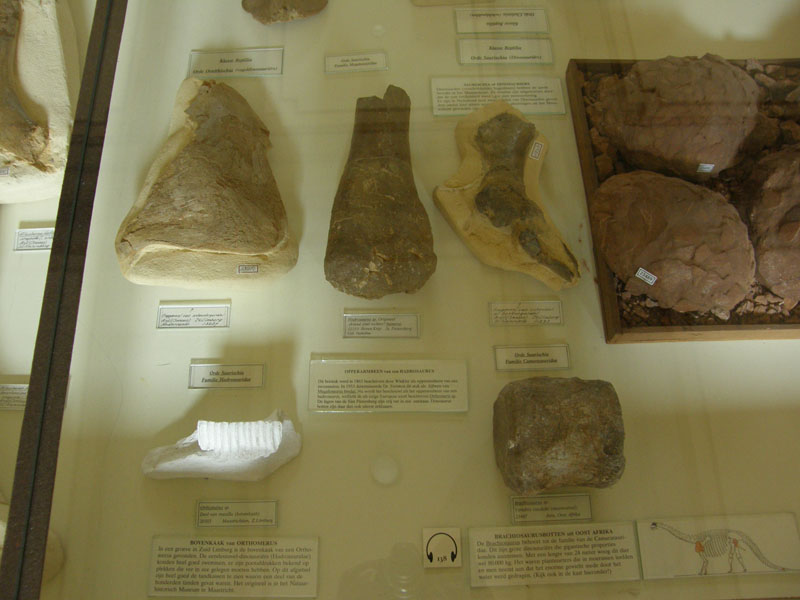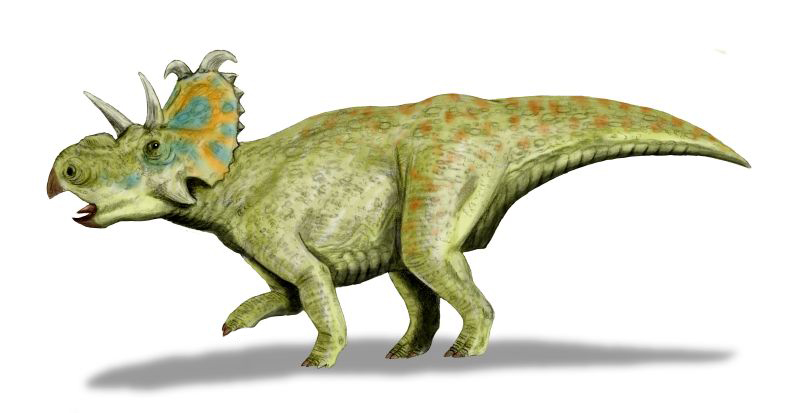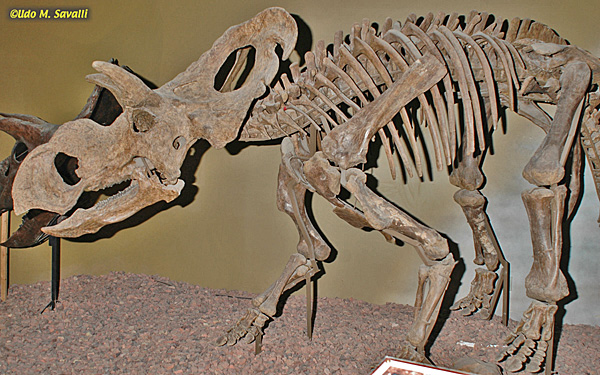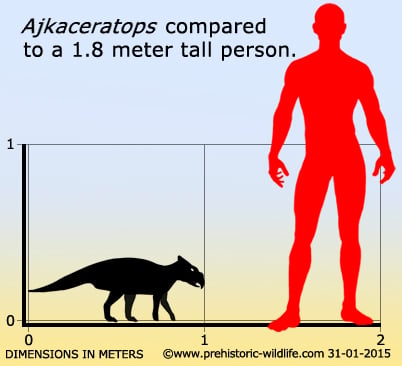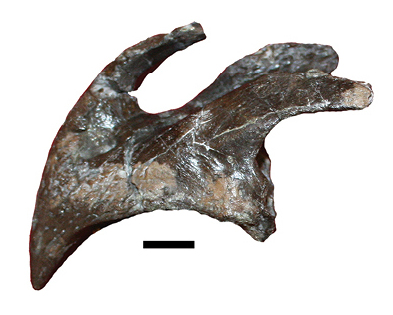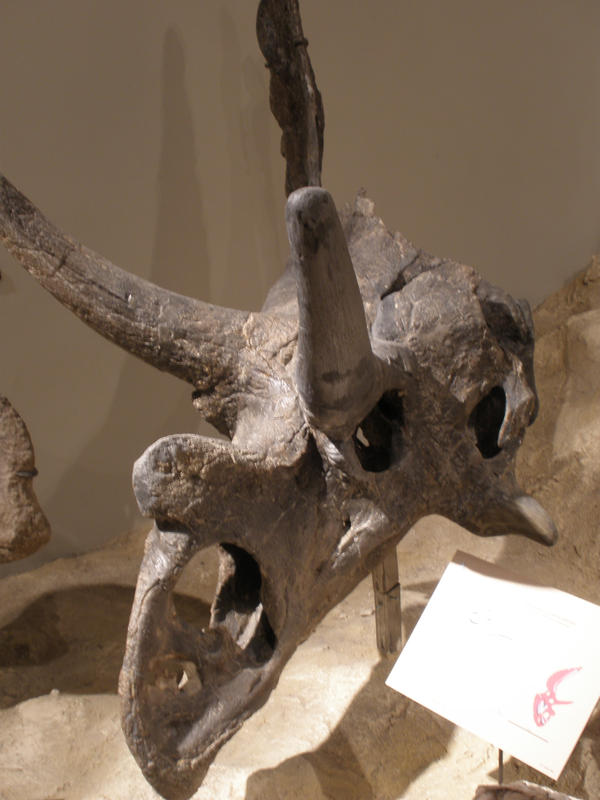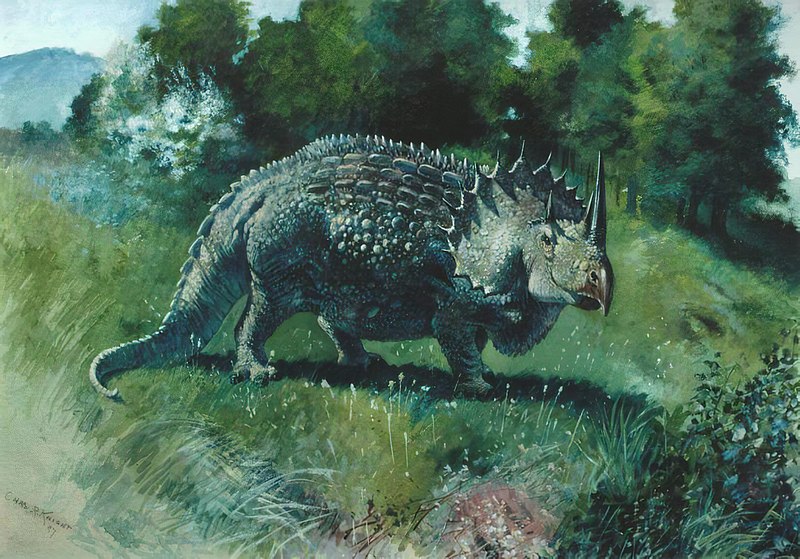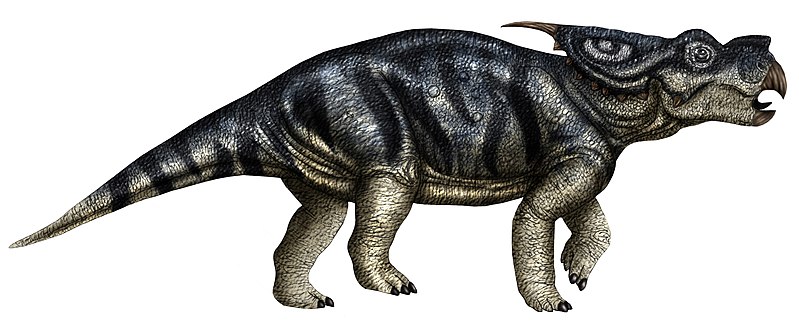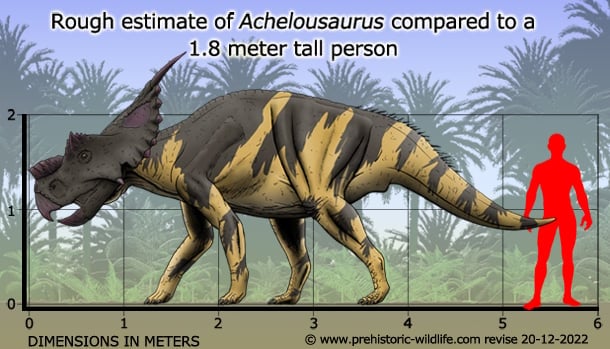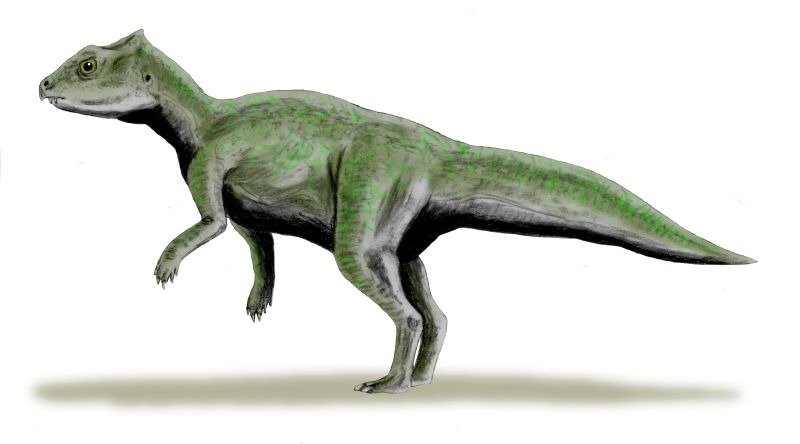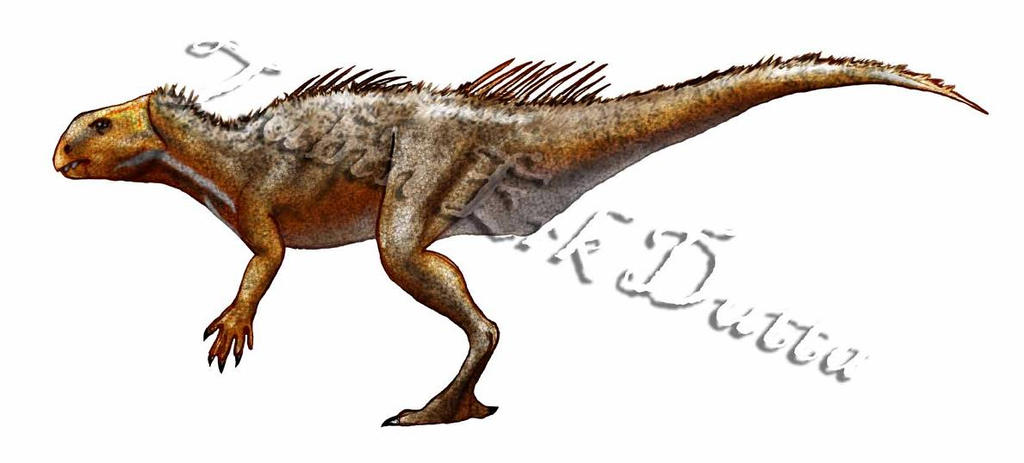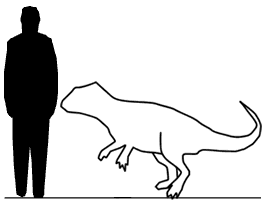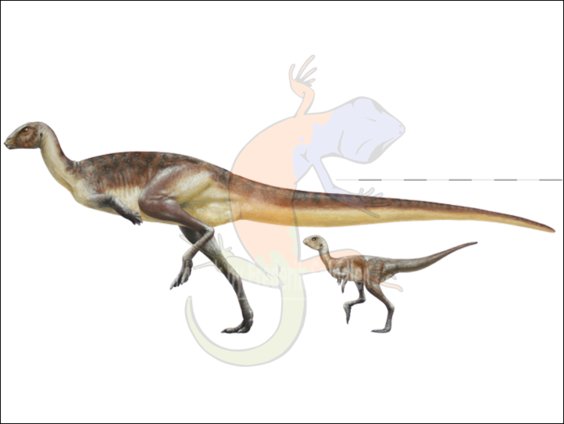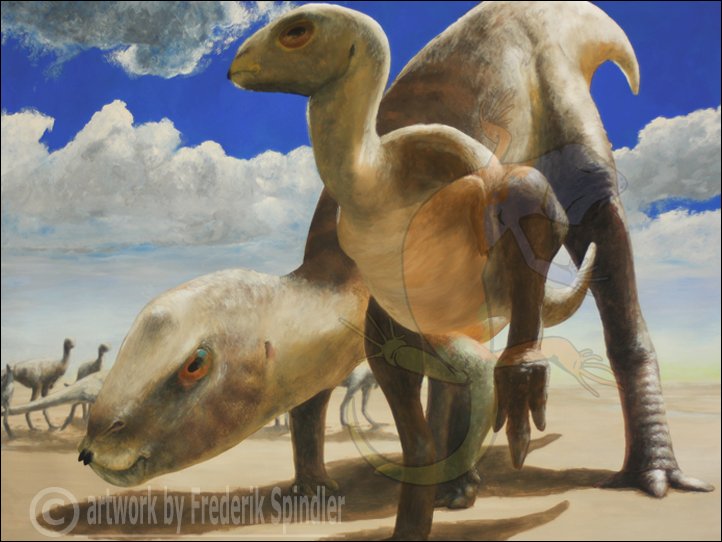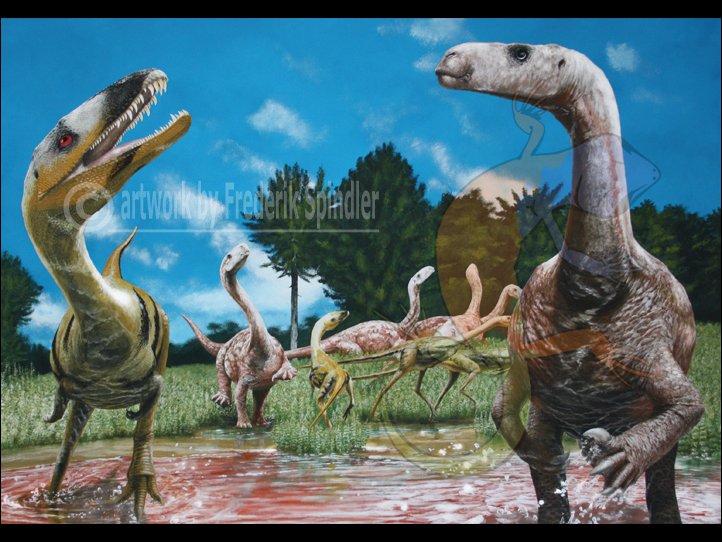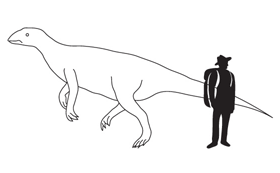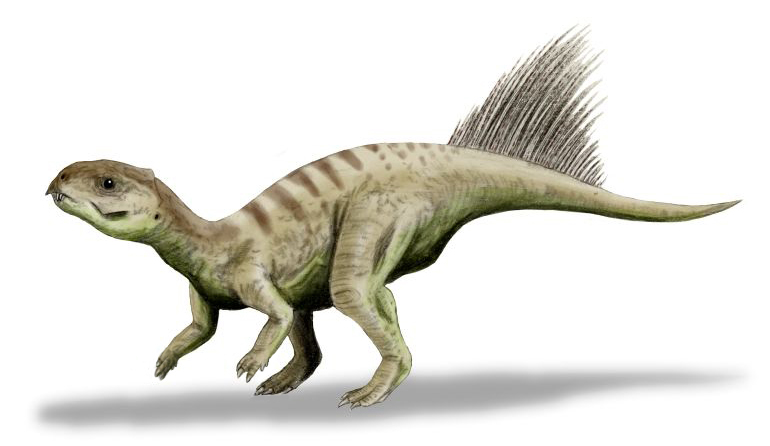[Recent Entries][Archive][Friends][User Info]
Below are the 17 most recent journal entries recorded in the "Сообщество, посвящённое ра" journal:| March 13th, 2016 | |
|---|---|
| 03:06 pm [industrialterro] [Link] |
Amurosaurus Амурозавр (Amurosaurus) — птицетазовый динозавр из подсемейства ламбеозаврины (Lambeosaurinae). Единственный известный вид — Amurosaurus riabinini. Амурозавр обитал на Земле в конце позднего мела, 74—65 миллионов лет назад. Как и большинство ламбеозаврин, амурозавр был двуногим травоядным ящером из семейства гадрозавриды — «утконосых динозавров» с полым гребнем на вершине головы. Сам гребень амурозавра не был найден. Окаменелые кости взрослых экземпляров очень редки, но по имеющимся останкам можно судить, что амурозавр был длиной от 6 до 8 метров. Российские палеонтологи Юрий Болотский и Сергей Курзанов описали и дали название этому динозавру в 1991 году. Название произошло от реки Амур и древнегреческого слова sauros («ящер»). Река Амур протекает на границе России и Китая, где и были найдены останки данного динозавра. Объем мозга амурозавра был больше, чем у большинства других травоядных динозавров. Относительно большой мозг указывает на сложное поведение. Возможно, это отчасти адаптация к стайному образу жизни. Останки амурозавра хранятся в Хабаровском Краеведческом музее имени Гродекова. В музее также имеется модель динозавра в натуральную величину. Russian paleontologists Yuri Bolotsky and Sergei Kurzanov first described and named this dinosaur in 1991. The generic name is derived from the Amur River and the Greek word sauros ("lizard"). The Amur (called Heilongjiang or "Black Dragon River" in Chinese) forms the border of Russia and China, and is near where this dinosaur's remains were found. There is one known species (A. riabinini), named in honor of the late Russian paleontologist Anatoly Riabinin, who conducted the first Russian expeditions to recover dinosaur remains in the Amur region in 1916 and 1917. All fossils of Amurosaurus have been recovered from a single bonebed locality, discovered in 1984 within the city limits of Blagoveschensk in the Amur Oblast of far eastern Russia. This bonebed is found in the Udurchukan Formation, the oldest geologic formation in the Tsagayan Group of far eastern Russia and northeastern China. This formation is thought to belong to the Maastrichtian stage of the Late Cretaceous Period, which was deposited 66 million years ago in the equivalent of the Lancian faunal stage of North America. The sediments were laid down in the floodplain of a river, which transported the fossils, but only a short distance, judging by the randomly assorted, disarticulated, but well-preserved bones within the bonebed, including fragile skull elements. Only a small section of the bonebed has been uncovered, but 90% of the remains found so far belong to lambeosaurines like Amurosaurus, mostly juveniles, with the rest belonging to other taxa, such as the hadrosaurine Kerberosaurus. Theropod teeth are also abundant, and there are many toothmarks on the bones, made by predators or scavengers. The holotype, or original specimen, consists of only a maxilla (upper jaw bone), and a dentary (lower jaw bone), both from the left side of the same individual. However, most of the other bones of the skull and skeleton have also been preserved in the bonebed, albeit of many different individuals. This other material was described more recently, making Amurosaurus the most abundant and completely known Russian dinosaur. Amurosaurus is characterized by many autapomorphies, or unique features, of the skull, as well as the sigmoidal shape of the ulna (a lower arm bone) when viewed from the front or side. Most other known lambeosaurines have hollow crests on the top of their skulls, and although the bones that would make up such a crest are unknown in this dinosaur, the bones of the roof of the skull are modified to support one, so it can be assumed that Amurosaurus was crested as well. As most of its features were described recently, as of early 2006, Amurosaurus has only been subjected to one cladistic analysis, which placed it as a basal member of the lambeosaurine subfamily of hadrosaurs, but more derived than either Tsintaosaurus or Jaxartosaurus. All known basal lambeosaurines come from Asia, which has led to the hypothesis that lambeosaurines originated there and then later dispersed across the Bering Strait to North America. Two derived groups, the parasaurolophins (Parasaurolophus, Charonosaurus) and lambeosaurins (Corythosaurus, Nipponosaurus, Lambeosaurus, etc.) evolved later. As members of both groups are found in North America and Asia (And one from Europe, which one is not solidly known), there must have been further dispersal after their evolution, although in which direction that dispersal occurred is still unclear. ( Read More ) Гадрозавриды, или гадрозавры (Hadrosauridae) — семейство так называемых «утконосых» динозавров, подотряд орнитопод, которое делится на два подсемейства — гадрозаврины и ламбеозаврины. Время существования — меловой период. Для семейства гадрозавров характерен гребень различных форм. В этом гребне находились носовые полости, которые, вероятно, служили для издавания громких звуков. Гадрозавры имели плоский беззубый, схожий с утиным, клюв, а в задней части челюсти находилось множество плоских зубов. Передвигались как на двух, так и на четырёх конечностях. Имели длинные задние и более короткие передние лапы. Длинный плоский хвост служил для равновесия. Гадрозавриды вели стадный образ жизни, строили гнёзда, охраняли кладку и вместе заботились о потомстве. Долгое время гадрозавров, из-за строения передних конечностей с перепонками между 4 и 5 пальцами и плоским хвостом, считали полуводными водорослеядными животными. Сейчас же семейство «утконосых динозавров» относят к наземным обитателям. В желудке хорошо сохранившегося эдмонтозавра было найдено большое количество хвои, а не водорослей. Также установлено, что на передних конечностях у гадрозаврид были копытца, а под хвостом имелся мясистый нарост, из-за которого плавание было бы просто невозможным. Останки гадрозавров обнаружены в Азии, Антарктиде, Европе, Северной и Южной Америке. Lambeosaurinae — группа птицетазовых динозавров из семейства гадрозавридов, характерной особенностью которых является костное образование на голове. Lambeosaurinae включают в себя две трибы — Parasaurolophini (Parasaurolophus) и Corythosaurini (Corythosaurus, Hypacrosaurus и Lambeosaurus). Corythosaurini и Parasaurolophini были введены в научную литературу в 2007 году. Corythosaurini определяются как все таксоны, более тесно связанные с Corythosaurus casuarius, чем с Parasaurolophus walkeri и Parasaurolophini — все таксоны, более близко связанные с P. walkeri, чем с C. casuarius. Ископаемые останки и реплики (1, 2, 3, 4, 5): Tags: Вымершие рептилии, Мел, авеметатарзалии, анкилополлексии, архозавроморфы, архозавры, гадрозавриды, гадрозавроиды, диапсиды, динозавроморфы, динозавры, игуанодонты, ламбеозаврины, неорнитискии, орнитоподы, птицетазовые, цераподы |
| April 24th, 2015 | |
| 04:28 pm [industrialterro] [Link] |
Altirhinus Альтири́н (Altirhinus) — род птицетазовых динозавров из семейства игуанодонтид. Все окаменелости этого динозавра были найдены в 1981 году совместной Советско-Монгольской экспедицией в геологической формации Khukhtek, на территории Восточно-Гобийского аймака. Khukhtek датируется 125—100 миллионами лет, что относится к отложениям нижнего мела альбского—аптского ярусов. Известно несколько окаменелых скелетов. Типовым экземпляром является хорошо сохранившийся череп, а также некоторый посткраниальный материал, состоящий из частичных останков конечностей, плечевого и тазового поясов. Второй экземпляр включает частичный череп, связанный с рёбрами, фрагментарными позвонками, а также полными передними конечностями. Третий образец состоит из многих костей конечностей и 34 хвостовых позвонков оставшихся от меньшей особи. Невдалеке были обнаружены два скелета, вероятно, принадлежащим молодым особям этого вида. Первоначально останки альтирина были отнесены к виду Iguanodon orientalis, который был выделен в 1952 году. Однако, как показали дальнейшие исследования название Iguanodon orientalis было основано на чрезвычайно фрагментарных останках, которые вероятно на самом деле принадлежали Iguanodon bernissartensis. Останки, обнаруженные в Монголии, не соответствовали останкам игуанодона, поэтому в 1998 году они были выделены в отдельный род и вид. Altirhinus was herbivorous and bipedal when walking or running, but probably became quadrupedal when feeding from the ground. According to the original description, the entire body probably extended 26 feet (8 m) from snout to tail tip. In 2010 Gregory S. Paul estimated the length at 6.5 metres (21 ft), the weight at 1.1 tonnes. The skull alone is about 30 inches (760 mm) long, with a wide mouth and a distinctive tall arch on top of its snout, from which this dinosaur derives its name. All known specimens of Altirhinus were recovered in 1981 during collaborative expeditions organized by Soviet and Mongolian scientists, from the Khukhtek Formation in the Dornogovi Province of Mongolia. The Khukhtek was formed in the Aptian to Albian stages of the Early Cretaceous Period, which lasted from between 125 and 100 million years ago. Psittacosaurus and the primitive ankylosaurid Shamosaurus have also been found in these rocks. Several fossil specimens of different ages and sizes are known. The holotype, PIN 3386/8, is a skull, which is well preserved on the left side, as well as some postcranial material consisting of pieces of the hands, feet, shoulder and pelvic girdles. A more fragmentary skull was also recovered, associated with some ribs, fragmentary vertebrae, and a complete forelimb. A third specimen preserves many limb bones and a series of 34 tail vertebrae from a smaller individual. Two even smaller fragmentary skeletons, presumably of young individuals, were uncovered nearby. The remains of this animal were originally referred to the species Iguanodon orientalis, which was first described in 1952. However, I. orientalis has since been shown to be fragmentary, nondiagnostic, and virtually indistinguishable from the European I. bernissartensis (Norman, 1996). As no features of I. orientalis are shared exclusively with the 1981 specimens, which are clearly distinguishable from Iguanodon, a new name for those specimens was required. British paleontologist David B. Norman named them Altirhinus kurzanovi in 1998. The name was created from a Latin word, altus ("high") and a Greek word, ῥίς, rhis, genitive rhinos ("nose" or "snout"). There is one known species (A. kurzanovi), which honors Sergei Kurzanov, the influential Russian paleontologist who originally found the specimens in 1981. Altirhinus is definitely an advanced iguanodontian, just basal to the family Hadrosauridae, but there is little agreement on the arrangement of genera and species in this area of the ornithopod family tree. In the original description, it was included with Iguanodon and Ouranosaurus in a family Iguanodontidae (Horman, 1998). More recent analyses all find Altirhinus more derived than either of those two genera, but less than Protohadros, Probactrosaurus, and hadrosaurids (Head, 2001; Kobayashi & Azuma, 2003; Norman, 2004). The former two studies also place Eolambia between Altirhinus and hadrosaurids, while Norman's analysis finds that the two genera share a clade. Fukuisaurus is just basal to Altirhinus according to the only analysis in which the former has been included (Kobayashi & Azuma, 2003). Many aspects of Altirhinus' anatomy allow speculation on its behavior. As its forelimbs were roughly half the length of its hindlimbs, Altirhinus appears to have been primarily bipedal. However, its carpals (wrist bones) were thick and blocky, and the three middle fingers of its hand were wide, hyperextendable, and ended in hoof-like bones. This indicates that the forelimbs were also capable of supporting weight. Like many ornithopods, Altirhinus may have spent a significant amount of time in a quadrupedal position, perhaps while feeding. While the three middle digits of each forelimb (digits II, III, & IV) were very thick and probably weight bearing, the outside fingers (digits I & V) were modified in different ways. The first digit was a simple sharp spike, as seen in Iguanodon. Aside from defense, the thumb spike could possibly have also been used for breaking the shells of seeds or fruit. The fifth digit was somewhat opposable to the rest of the hand and may have been useful for grasping food. There is a large diastema, or gap, between the keratinous beak on the front of the mouth and the main chewing teeth in the side of the mouth, which would allow the two sections to work independently, so Altirhinus could crop with its beak while simultaneously chewing with its teeth. Many herbivorous mammals show a similar adaptation and can crop with their incisors without disturbing their chewing molars. Altirhinus was one of a number of advanced iguanodontians with snouts expanded outwards towards the end. This is quite possibly an example of convergent evolution with hadrosaurids, famous for their wide "duckbill" snouts. These adaptations are also paralleled in many living mammalian herbivores of different lineages. Modern cows, horses, and white rhinoceros all exhibit wide muzzles and all are grazing animals. Grazing most often occurs at ground level, and if the expanded muzzles of Altirhinus and other related species were an adaptation to grazing, this may also explain corresponding weight-bearing adaptations of the forelimbs in derived iguanodontians, in order to get the head closer to the ground. The characteristic arched snout of Altirhinus was formed primarily by the nasal bones, and a similar structure is seen on the snout of the Australian Muttaburrasaurus. Many different functions have been proposed for the nasal arch. It may have housed tissues to cool the blood, conserve water, or enhance the sense of smell. Alternatively, it may have facilitated communication through vocalization or visual display. As only two skulls have been located, it is entirely possible that the arched snout is only found in one gender, in which case it may have been used for sexual display, like in modern-day elephant seals. Гадрозавроиды (Hadrosauroidea) — клада или надсемейство птицетазовых динозавров, который включает в себя «утконосых» динозавров, или гадрозавридов, а также их близких родственников. Жили в меловом периоде на всех континентах планеты. Предполагается, что гадрозавроиды возникли в Азии и а потом широко расселились в другие части света. Самые ранние находки представителей данной группы относятся к аптскому веку раннего мелового периода, около 125 млн лет назад — это Probactrosaurus, живший на территории Китая, и Siamodon nimngami, найденный в Таиланде. Впервые название таксону дано Полом Серено в 1986 году в качестве подтаксона Iguanodontoidea. Ныне данная классификация не используется, и разные ученые предположительно относят гадрозавроидов либо к группе Hadrosauriformes (например Пол Серено в 1999 году и Годефруа (Godefroit) с коллегами в 2004 году), либо к группе Iguanodontia (например Ruiz-Omeñaca в 2006 году). Многие примитивные гадрозавроиды, такие как Ouranosaurus, традиционно включались в парафилетические группы игуанодонтидов. После кладистического анализа традиционных игуанодонтидов, данная группа в значительной степени распалась, и на данный момент включает в себя только игуанодона и его ближайших родственников. Размеры тела в сравнении с человеком: Tags: Вымершие рептилии, Мел, авеметатарзалии, анкилополлексии, архозавроморфы, архозавры, гадрозавроиды, диапсиды, динозавроморфы, динозавры, игуанодонты, неорнитискии, орнитоподы, птицетазовые, цераподы |
| April 15th, 2015 | |
| 08:56 pm [industrialterro] [Link] |
Albertaceratops Альбертацератопс (Albertaceratops; букв. «рогатая морда из Альберты») — род птицетазовых динозавров из семейства цератопсид, живших в раннем меловом периоде (около 83,5—70,6 миллионов лет назад) на территории нынешней Северной Америки. Окаменелости динозавра были найдены на территории провинции Альберта (Канада) и штата Монтана (США). Впервые описан палеонтологом Ryan в 2007 году. Всего известно два скелета Albertaceratops. Представлен одним видом — Albertaceratops nesmoi. Albertaceratops (meaning "Alberta horned face") was a genus of centrosaurine horned dinosaur from the middle Campanian-age Upper Cretaceous Oldman Formation of Alberta, Canada. Albertaceratops is known from a single complete skull (TMP.2001.26.1) found in August 2001 and skull and postcranial fragments. This genus is unusual in combining long brow horns with an otherwise centrosaurine skull, as centrosaurines normally possess short brow horns. Over its nose was a bony ridge, and on its frill were two large outwardly-projecting hooks. A phylogenetic analysis carried out by its describer, Michael J. Ryan, found it to be the most basal centrosaurine. Additional specimens were reported from a bonebed in the Judith River Formation of Montana, which is equivalent to the Oldman Formation and differentiated only by the United States/Canadian border. However, further study showed these remains to come from a chasmosaurine, Medusaceratops. Both ceratopsids lived during the same time period, about 77.5 million years ago. The specific name, A. nesmoi, is derived from the name of Cecil Nesmo, a rancher living in Manyberries, Alberta, a town of less than 100 people located 71 km south of Medicine Hat. The rancher was thus honored in recognition of his efforts to aid fossil hunters. Репродукции (1, 2, 3, 4, 5, 6): Размеры тела в сравнении с человеком: Tags: Вымершие рептилии, Мел, авеметатарзалии, архозавроморфы, архозавры, диапсиды, динозавроморвф, динозавры, маргиноцефалии, неорнитискии, птицетазовые, центрозаврины, цераподы, цератопсиды, цератопсы |
| 08:13 pm [industrialterro] [Link] |
Albalophosaurus Альбалофозавр (Albalophosaurus) — род птицетазовых динозавров подотряда цераподов, живших в раннем меловом периоде (около 145—140 миллионов лет назад), на территории нынешней Азии. Окаменелости теропода были найдены в геологической формации Kuwajima Formation в Японии. Впервые описан палеонтологами Ohashi и Barrett в 2009 году. Представлен одним видом — A. yamaguchiorum. В результате кладистического анализа было установлено, что Albalophosaurus относится к группе Cerapoda. Другие характеристики, такие как морфология зубов Albalophosaurus предполагают отнесение данного рода к Ornithopoda. Учитывая много недостающей информации исследователи ограничились размещением данного таксона Cerapoda указав его как incertae sedis. Albalophosaurus (meaning 'white crest lizard') is a genus of ceratopsian ornithischian dinosaur. It was described in 2009 from remains found in 1997 by Yoshinori Kobayashi from the Kuwajima Formation of central Japan, outcropping in Hakusan in the Ishikawa Prefecture. The holotype, SBEI 176, consists of cranial bones from an incomplete, disarticulated skull and left lower jaw thought to belong to a single individual. The type species is named A. yamaguchiorum. The generic name is derived from Latin albus, "white", and Greek λόϕος (lophos), "crest", a reference to the snow-covered crest of Mount Hakusan. The specific name honours Ichio Yamaguchi en Mikiko Yamaguchi, who discovered and prepared many fossils from the site. The exact age of the strata from which the remains of Albalophosaurus have been found is not known because of the lack of marine beds containing index fossils, but the Kuwajima Formation is known to have formed during the Early Cretaceous, most likely after the Berriasian and before the Barremian based on the ages of underlying and overlying formations. More recent studies suggest that the age of the Kuwajima Formation is most likely Valanginian—Hauterivian, although the exact age is still uncertain. Although Albalophosaurus was classified as a basal ceratopsian in a phylogenetic analysis conducted along with the description of the genus, only one ambiguous synapomorphy of the clade is present in the holotype, and none of the unambiguous synapomorphies that define Ceratopsia are present. Other characteristics, such as those of the dental morphology of Albalophosaurus, seem to suggest that the genus shares a relation to Ornithopoda. Thus the authors of the original description of the genus refer it to Cerapoda incertae sedis, and do not consider it to be a ceratopsian. Han et al., 2012 found Albalophosaurus to be a ceratopsian more derived than Micropachycephalosaurus, Yinlong, Stenopelix, and Chaoyangosaurus, but basal to a clade composed of Psittacosaurus and more derived ceratopsians. Tags: Вымершие рептилии, Мел, авеметатарзалии, архозавроморфы, архозавры, диапсиды, динозавроморфы, динозавры, маргиноцефалии, неорнитискии, птицетазовые, цераподы, цератопсы |
| April 6th, 2015 | |
| 08:22 pm [industrialterro] [Link] |
Alaskacephale Alaskacephale was a genus of pachycephalosaurid dinosaur that lived in the late Campanian to Maastrichtian stages of the Late Cretaceous (around 80 to 69 million years ago). Alaskacephale was named by Robert Sullivan in 2006. The genus name refers to Alaska, where the fossil was found in the Prince Creek Formation. The species name, gangloffi, honors paleontologist Roland Gangloff. The only known specimen of A. gangloffi is the holotype, a nearly complete left squamosal with a characteristic array of polygonal nodes. The dimensions of this bone suggest that A. gangloffi was about half the size of Pachycephalosaurus wyomingensis or three quarters the size of Prenocephale prenes, and about the same size as Prenocephale edmontonensis and Prenocephale brevis. The specimen was previously described by Gangloff et al. (2005) as an unnamed pachycephalosaurid, possibly a Pachycephalosaurus. Gangloff et al. described the squamosal as having a suture with the quadrate, a feature previously described only in Pachycephalosaurus. Sullivan (2006) opined that this "suture" is instead a breakage point in both Alaskacephale and Pachycephalosaurus, so it could not be used to unite the two taxa. Аляска известна не только суровым климатом и потрясающей природой. Здесь располагается богатая формация Принс-Крик, которая, на радость палеонтологов всего мира, регулярно поставляет новые таксоны динозавров. Рассмотрим первого и пока единственного обнаруженного там пахицефалозавра. Латинское название Alaskacephale происходит от древнегреческого слова "голова" и "Аляска". Существовали аляскацефалы в конце мелового периода, около 72 – 68 миллионов лет назад (ранний маастрихтский ярус). Были распространены на территории Соединённых Штатов Америки, в Аляске. Ныне известен единственный вид – Alaskacephale gangloffi, соответственно являющийся типовым. Единственный обнаруженный экземпляр аляскацефала (соответственно, голотип) получил идентификационный номер UAM AK-493-V-001. Он представляет собой чешуйчатую кость с характерными рядами конусовидных выростов – части обрамления купола. Аналогичное имелось у североамериканского родича – пахицефалозавра (Pachycephalosaurus). Длина тела аляскацефала достигала 2,25 метров. Высота доходила до 0,9 метров, а весил этот ящер около 40 кг. Североамериканская свита Принс-Крик, с лихвой насыщенная водоёмами, в начале маастрихта стала прибежищем многих растительноядных динозавров от мала до велика. По соседству с небольшим аляскацефалом могли проживать даже внушительные эдмонтозавры (Edmontosaurus) и пахиринозавры (Pachyrhinosaurus). Кто же мог представлять для аляскацефала угрозу? Этот ящер наверняка обладал неплохой скоростью передвижения. В этой формации обнаружены троодоны (Troodon), заврорнитолесты (Saurornitholestes) и ещё один неидентифицированный дромеозаврид ("Dromaeosaurus albertensis"). Эти хищники были хорошо вооружены и достаточно быстры для охоты на аляскоцефала, тем более что они могли атаковать добычу группами. Пахицефалоза́вры (Pachycephalosauria) — инфраотряд травоядных динозавров из группы Marginocephalia. Название впервые было использовано Марианской и Осмольской в 1974 году, но до сих пор точного таксономического определения данной группе не дано. В 1998 году Пол Серено предложил следующее определение: все виды, которые менее тесно связаны с трицератопсом, чем с Pachycephalosaurus. Вагнер в 2004 году в своём обзоре The Dinosauria дал другое определение: все виды, связанные ближе с Pachycephalosaurus wyomingensis чем с Triceratops horridus. В 2005 году Серено дал более сложное определение: все виды, более тесно связанные с Pachycephalosaurus wyomingensis, чем с Heterodontosaurus foxii, Ankylosaurus magniventris, Stegosaurus armatus, Iguanodon bernissartensis и Ceratops montanus. Выделение данной группы осложняется из-за многих неопределённостей внутренних взаимоотношений видов в отряде птицетазовых динозавров. Представители группы обитали с берриасского по маастрихтский века (146 до 65 млн. лет назад) на территории Азии и Северной Америки. Другие известные виды — Stygimoloch и Dracorex, которые иногда рассматриваются в качестве синонима рода Pachycephalosaurus. ( Read More ) Tags: Вымершие рептилии, Мел, авеметатарзалии, архозавроморфы, архозавры, диапсиды, динозавроморфы, динозавры, маргиноцефалии, неорнитискии, пахицефалозавры, птицетазовые, цераподы |
| March 1st, 2015 | |
| 07:52 pm [industrialterro] [Link] |
Ajkaceratops Айкацератопс (Ajkaceratops; от венгер. «Ajka» Айка — город в Венгрии и «ceratops» — рогатая морда) — род травоядных динозавров инфраотряда цератопсов, обитавший в меловом периоде (около 85 млн лет назад) на территории нынешней Европы. Типовой вид — Ajkaceratops kozmai. В длину взрослый Ajkaceratops достигал 1 метра. Окаменелые останки были найдены в 2009 году группой палеонтологов под руководством Аттилы Оси (Atilla Ösi) из Венгерской Академии Наук (Hungarian Academy of Sciences) на территории современной Венгрии в бокситовых рудниках Ихаркут близ города Айка и описаны в 2010 году. Описан по верхним и нижним частям клюва. Ученые предполагают, что A. kozmai начал своё путешествие из Азии и, двигаясь от острова к острову, постепенно уходил всё дальше на запад (в современную Европу). Ajkaceratops схож по строению с азиатскими видами цератопсов Bagaceratops и Magnirostris, что дает возможность предположительно отнести его к семейству протоцератопсидов, однако точную принадлежность установить трудно из-за недостаточного количества костей. Сравнение окаменелостей путем кладистического анализа говорит о том, что Ajkaceratops является цератопсидом, близким к Bagaceratops, но более примитивным, чем Zuniceratops и Ceratopsidae. На основе исследования окаменелостей Ajkaceratops Оси (2010) определил данного динозавра как базальный род клады Coronosauria. The holotype, cataloged as MTM V2009.192.1, consists only of a few skull fragments, including rostral bones, fused premaxillae, and maxillae fragments (the beak and jaw fragments). These fossils are kept in the Hungarian Natural History Museum, in Budapest. Although the fossils are fragmentary, the paper describing Ajkaceratops estimated a body length of 1 m (3.3 ft). Other material includes four predentary bones, cataloged as MTM V2009.193.1, V2009.194.1, V2009.195.1, and V2009.196.1; these are also believed to have belonged to Ajkaceratops, although they are proportionately smaller, and probably came from other individuals of the genus. The fossils of Ajkaceratops were discovered in the Csehbánya Formation, which is interpreted as "a floodplain and channel deposit formed by variegated clay, silt with interbedded grey and brown sand, and sandstone beds". This strata dates to the Santonian stage, around 86 to 84 mya (million years ago). Ajkaceratops shared its environment with other dinosaurs such as Rhabdodon, nodosaurid ankylosaurs, and theropods, as well as non-dinosaurian eusuchian crocodiles, azhdarchid pterosaurs, bothremydid turtles, teiid lizards, and enantiornithine birds. Bagaceratopidae is a family of neoceratopsian dinosaurs. It was named by Alifanov in 2003 but no definition has been proposed. Because of lacking of the definition, Bagaceratopidae was considered inactive by Paul Sereno in 2005. Alifanov in 2003 classified to this family four genera: Bagaceratops, Breviceratops, Lamaceratops and Platyceratops and in a publication from 2008 he included in Bagaceratopidae also Magnirostris and newly described genus Gobiceratops. Alifanov suggested also that Bagaceratopidae, unlike other neoceratopsian families, is of Paleoasiatic origin. Bagaceratopids existed during the late Cretaceous period, between about 85.8 and 70.6 million years ago. Фрагменты черепа небольшого динозавра, относившегося к инфраотряду цератопсов (Ceratopsia), были найдены в Венгрии. Три фрагмента палеонтологи под руководством Аттилы Оси (Attila Osi) из Венгерской академии наук (Hungarian Academy of Sciences in Budapest) нашли в бокситовом карьере возле города Айка (Ajka). Палеонтологи назвали нового динозавра в честь этого города - Ajkaceratops kozmai. Статья, посвященная открытию этого динозавра, опубликована в журнале Nature. О том, что цератопсы обитали в Европе, палеонтологи догадывались уже давно. Ведь первые представители этой группы возникли в Азии, а своего расцвета цератопсы достигли в Азии и Северной Америке. Попасть в Америку минуя Европу в конце юрского и в меловом периоде было практически невозможно. Поэтому, логично было предположить, что они расселялись как раз через Европу, переплывая с острова на остров или мигрируя в те эпохи, когда море отступало и острова сливались между собой. Но костей в Европе ранее не находили, поэтому вопрос оставался открытым до обнаружения айкацератопса. Размеры тела в сравнении с человеком: Tags: Вымершие рептилии, Мел, авеметатарзалии, архозавроморфы, архозавры, багацератопсиды, диапсиды, динозавроморфы, динозавры, маргиноцефалии, неорнитискии, птицетазовые, цераподы, цератопсиды, цератопсы |
| February 22nd, 2015 | |
| 07:13 pm [industrialterro] [Link] |
Agujaceratops Агухацератопс (Agujaceratops) — род птицетазовых динозавров из семейства цератопсидов, группы маргиноцефалов, живших в позднем меловом периоде (около 83—70 миллионов лет назад), на территории нынешней Северной Америки. Окаменелости были найдены в округе Брюстер (Brewster) штата Техас, формации Агуха (Aguja Formation). Впервые описан палеонтологами Лукасом (Lucas), Салливаном (Sullivan) и Хантом (Hunt) в 2006 году. Представлен одним видом — A. mariscalensis. Известен только один скелет. Первоначально Леманом (Lehman) в 1989 году был назван Chasmosaurus mariscalensis. Экземпляр был пронумерован P.37.3.086 UTEP. Однако позже, в 2006 году, был рекомбинирован в A. mariscalensis Лукасом и его коллегами. In 1938, three dinosaur bone beds were excavated, and ceratopsian material was collected from Big Bend National Park (Texas) by William Strain. This material was studied by Lehman in 1989 and named Chasmosaurus mariscalensis. It is known only from the holotype UTEP P.37.7.086 a partial adult skull which includes a braincase, left supraorbital horncore, left maxilla and a right dentary. Additional material was associated with the holotype, but not considered to be part of it. All specimens of Agujaceratops were collected from the lower part of the Upper Shale member of the Aguja Formation, dating to about 77 million years ago, in the Big Bend National Park, Brewster County. Subsequent analysis resulted in the taxon being put in its own genus. Agujaceratops was named by Spencer G. Lucas, Robert M. Sullivan and Adrian Hunt in 2006, and the type species is Agujaceratops mariscalensis. Agujaceratops is similar to both Pentaceratops and Chasmosaurus. Its short frill suggests it probably was not an ancestor of Pentaceratops. Агухацератопс был типичным представителем семейства цератопсид, жившим примерно 83-70 миллионов лет назад (кампанский ярус), на территории Северной Америки (США). Агухацератопс был длинной примерно в восемь метров, высотой почти до трех метров и как предполагают ученые весил около двух тонн. Динозавр имел черепной воротник схожий с воротником пентацератопса (родственного ему вида), который был более вертикально расположен и в длину немного короче. На тыльной стороне ободка воротника наблюдается достаточно глубокая вырезка. Череп массивный и тяжелый, в длину составлял примерно от метра до метра шестидесяти сантиметров. Над глазами находились два рога среднего размера, практически одинаковые и еще один небольшой рог располагался на носу. Рога были прямые, чуть загнутые кверху. Скорее всего, агухацератопс использовал свои внушительные рога для защиты при нападении хищников или при решении спорных вопросов во внутрисемейных конфликтах. По предположениям ученых-палеонтологов по морфологическим особенностям рогов и окраске данные динозавры могли определить возраст родственной особи, ее положение и авторитет в стаде. ( Read More )
Размеры тела в сравнении с человеком: Tags: Вымершие рептилии, Мел, авеметатарзалии, архозавроморфы, архозавры, диапсиды, динозавроморфы, динозавры, маргиноцефалии, неорнитискии, птицетазовые, хасмозаврины, цераподы, цератопсиды, цератопсы |
| February 18th, 2015 | |
| 06:23 pm [industrialterro] [Link] |
Agathaumas Агатаум (от Agataumas — «огромное изумление») — сомнительный род динозавров семейства Цератопсиды, живших 70—65 млн лет назад (середина кампанского — конец маастрихского яруса позднего мелового периода) на территории нынешней Северной Америки. Достигал в длину 9 метров, высоты 3 метра и веса 5 тонн. Окаменелости агатаума были найдены в округе Суитуотер (Sweetwater County) штата Вайоминг. Впервые описан палеонтологом Коупом в 1874 году. Представлен одним видом — Agathaumas sylvestris. Останки агатаума обнаружил американский учёный Ф. Меек в 1873 году при раскопках в штате Вайоминг (США). Он сообщил об этом известному палеонтологу Эдварду Коупу, который немедленно прибыл на место и занялся изучением находки. Название своё — «огромное изумление» — агатаум получил потому, что учёные были сильно потрясены размерами животного. В 1897 году художник Чарльз Найт по заказу Э. Коупа сделал ряд рисунков ящера, которые в 1925 году послужили Уиллису О’Брайну основой для создания образа агатаума в фильме «Затерянный мир». Agathaumas (/æɡəˈθɔːməs/; "great wonder") is a dubious genus of a large ceratopsid dinosaur that lived in Wyoming during the Late Cretaceous (late Maastrichtian stage, 66 million years ago). The name comes from Greek, αγαν - 'much' and θαυμα - 'wonder'. It is estimated to have been 9 metres (30 ft) long and weighed 6 tonnes (5.9 long tons; 6.6 short tons), and was the largest land animal known at the time of its discovery. It was the first ceratopsian known to science, though relatively little is known about it. The original specimen consisted only of the animal's hip bones, hip vertebrae and ribs, and because these bones vary little between ceratopsid species, it is usually considered a nomen dubium. It is provisionally considered a synonym of Triceratops, but is difficult to compare to that genus because it is only known from post-cranial remains. The fossil remains of Agathaumas were first found in 1872 in southwestern Wyoming. They were discovered by Fielding Bradford Meek and H.M. Bannister while they were looking for fossil shells in the Lance Formation (then Laramie Formation) near the Black Butte and Bitter Creek. Meek and Bannister were employed by Ferdinand Hayden's Geological Survey of the Territories, and notified paleontologist Edward Drinker Cope of the find. Cope himself searched the ridge near Black Butte and re-discovered Meek's site, finding huge bones protruding from the rocks near a coal vein. The bones were preserved in sand and clay sediments, packed with fossil sticks and leaves, indicating a heavily forested habitat. Cope later (in 1873) described the skeleton as "the wreck of one of the princes among giants." Later in 1872, Cope published a description and name for the animal, Agathaumas sylvestris, or "marvelous forest-dweller," in reference to its great size and the environment revealed in the same rocks as its bones. The name Agathaumas has been cited as an example of Cope's excitement with this discovery, which was, at the time, the largest known land animal that had ever lived (until several years later, with the discovery of the giant sauropod dinosaurs of the Morrison Formation. Cope and his team eventually recovered complete hip bones, sacral vertebrae, and several ribs from the animal. Since these were the first ceratopsian remains found, Cope was uncertain as to precisely what sort of dinosaur Agathaumas was (and for a time considered it a hadrosaur) until O. C. Marsh described Triceratops in 1889. In an 1889 paper, Cope suggested that Marsh's Ceratopsidae be renamed Agathaumidae, because of the paucity of Ceratops remains. Unfortunately, the bones of the rear half of the animal found are not particularly diagnostic in ceratopsians and Agathaumas remains a nomen dubium. No other remains have been found in the area, but based on its size and age of the rocks, it probably was a Triceratops. Хасмозаврины или цератопсины (Chasmosaurinae или Ceratopsinae) — подсемейство птицетазовых динозавров, обитавших в позднем меловом периоде (около 77—65 миллионов лет назад). Все известные виды были четвероногими и обитали в основном в Северной Америке хотя один вид, Тураноцератопс, известен из отложений Азии. Большинство представителей этого подсемейства обладают лишь шишковатыми «зачаточными» рожками, расположенными над глазницами, в отличие от своих ранних предков), тогда как трицератопс наоборот имеет крупные костяные наросты. Самым ранним из всех известных рогатых динозавров в Северной Америке является зуницератопс (Zuniceratops), живший 90 млн лет назад.
Tags: Вымершие рептилии, Мел, авеметатарзалии, архозавроморфы, архозавры, диапсиды, динозавроморфы, динозавры, маргиноцефалии, неорнитискии, птицетазовые, хасмозаврины, цераподы, цератопсиды, цератопсы |
| December 28th, 2014 | |
| 09:24 pm [industrialterro] [Link] |
Achelousaurus Ахелоузавр (Achelousaurus — «ящер Ахелоя») — род динозавров из группы цератопсов, живших в позднем меловом периоде 75—70 млн лет назад (с кампанского по маастрихский ярусы позднего мела), на территории нынешней Монтаны (США). Представлял собой четвероногого травоядного динозавра с попугаеобразным клювом, небольшими костными шишками на морде и двумя над глазницами, а также двумя рогами на вершине костистого нароста на шее. По мере роста животного костный нарост на носу увеличивался и становился направленным вперёд, а наросты над глазами становились бугристыми. Ахелоузавр достигал длины 6 метров, высоты 3,5 метра и веса в 2,5 тонны. Череп ахелоузавра достигал 1,6 метра в длину. В 1995 году палеонтолог Скотт Сэмпсон описал единственный вид этого рода — A. horneri. Видовой эпитет дан в честь Джека Хорнера, американского палеонтолога, известного своими открытиями динозавров в штате Монтана. Родовое название Achelousaurus дано в честь персонажа греческой мифологии Ахелоя — божества, в борьбе с Гераклом потерявшего один из рогов. На данный момент найдено всего три скелета ахелоузавров. The genus and the one named species (A. horneri) were both named by paleontologist Scott Sampson in 1995. The specific name honors Jack Horner, an influential American paleontologist famous for his Montana dinosaur discoveries, who in 1987 headed the team that excavated the holotype skull of Achelousaurus, MOR 485. The generic name Achelousaurus is a complex reference to Greek mythology. Achelous, an important Greek river deity, had one of his horns torn off by Hercules, in a mythological fight with the legendary hero. All three known skulls of Achelousaurus have rough bosses in the same places where other ceratopsians have horns, giving them the appearance of having had the horns ripped off. Achelous was also celebrated for his shapeshifting ability, just as Achelousaurus appear to combine features of other ceratopsian dinosaurs. Achelousaurus horneri are known from the U.S. state of Montana, in the Two Medicine Formation, which preserves sediments dated from the Campanian stage of the Late Cretaceous Period, between 83 and 74 million years ago. Achelousaurus specimens are found in the highest levels of the formation, probably closer to the end of that timeframe, 74 mya. Contemporary dinosaur species included Prosaurolophus blackfeetensis, Scolosaurus cutleri, Hypacrosaurus stebingeri, Einiosaurus procurvicornis, and tyrannosaurids of uncertain classification. Scientists have so far recovered three skulls and some postcranial material from the Two Medicine, all housed at the Museum of the Rockies in Bozeman, Montana. The skull of a full-grown Achelousaurus (including the frill horns) is over 5 feet (1.6 meters) long. Early reports suggested that Achelousaurus represented a transitional form, "Type C", between ceratopsians with modified horns like Einiosaurus, "Type B" (with which A. horneri shares two horns on the end of the frill), and the derived, hornless Pachyrhinosaurus (Horner et al., 1992). While they may or may not form a direct line of descent, all three of these genera are at least closely related, and are often united in the tribe Pachyrhinosaurini, inside the subfamily Centrosaurinae and the family Ceratopsidae (Sampson, 1995; Dodson et al., 2004). ( Read More ) Размеры тела в сравнении с человеком:
Tags: Вымершие рептилии, Мел, авеметатарзалии, архозавроморфы, архозавры, диапсиды, динозавроморфы, динозавры, маргиноцефалии, неорнитискии, птицетазовые, центрозаврины, цераподы, цератопсиды, цератопсы |
| January 25th, 2013 | |
| 01:50 pm [industrialterro] [Link] |
Yinlong Yinlong (meaning "hidden dragon") is a genus of basal ceratopsian dinosaur from the Late Jurassic Period of central Asia. It was a small, primarily bipedal herbivore, approximately 3 meters (9.8 ft) long. Yinlong is the oldest and most primitive ceratopsian known to science. A coalition of American and Chinese paleontologists, including Xu Xing, Catherine Forster, Jim Clark, and Mo Jinyou, described and named Yinlong in 2006. The generic name is derived from the Mandarin Chinese words 隱 (yǐn: "hidden") and 龍 (lóng: "dragon"), a reference to the movie Crouching Tiger, Hidden Dragon, large portions of which were filmed in the western Chinese province of Xinjiang, near the locality where this animal's fossil remains were discovered. Long is the word most often used in the Chinese media when referring to dinosaurs. The species was named after the late Will Downs, a frequent participant in paleontological expeditions to China, who died the year before Yinlong was discovered. The known fossil material of Yinlong consists of many skeletons and skulls. The first specimen discovered was a single exceptionally well-preserved skeleton, complete with skull, of a nearly adult animal, found in 2004 in the Middle-Late Jurassic strata of the Shishugou Formation located in Xinjiang Province, China. Yinlong was discovered in an upper section of this formation which dates to the Oxfordian stage of the Late Jurassic, or 161.2 to 155.7 million years ago. All other described ceratopsians are known from the later Cretaceous Period. A small rostral bone on the end of the upper jaw clearly identifies Yinlong as a ceratopsian, although the skull displays several features, especially the ornamentation of the squamosal bone of the skull roof, which were previously thought to be unique to pachycephalosaurians. The presence of these features in Yinlong indicates these as actual synapomorphies (unique features) of the larger group Marginocephalia, which contains both the pachycephalosaurs and the ceratopsians, although these features have been lost in all known ceratopsians more derived than Yinlong. The addition of these characters further strengthens the support for Marginocephalia. Yinlong also preserves skull features reminiscent of the family Heterodontosauridae, providing support for the hypothesis that heterodontosaurids are closely related to marginocephalians (Cooper, 1985; Zhao et al., 1999; You et al., 2003). The group containing Marginocephalia and Heterodontosauridae has been named Heterodontosauriformes (Xu et al., 2006). Yinlong was discovered with seven gastroliths preserved in the abdominal cavity. Gastroliths, stones stored in the digestive tract and used to grind plant material, are also found in other ceratopsians such as Psittacosaurus, and are also widely distributed in most other dinosaur groups, as well as in many types of birds.
Размеры тела в сравнении с человеком:
Ископаемые останки (1, 2, 3, 4):
Tags: Вымершие рептилии, Юра, авеметатарзалии, архозавроморфы, архозавры, диапсиды, динозавроморфы, динозавры, маргиноцефалии, неорнитискии, птицетазовые, цераподы, цератопсы |
| 11:55 am [industrialterro] [Link] |
Xuanhuaceratops Xuanhuaceratops is a genus of dinosaur from the Late Jurassic Period (dated to 148 million years ago). A member of the family Chaoyangsauridae, it was one of the earliest ceratopsians (Weishampel et al. 2004; Xu et al. 2006; Zhao et al. 2006). The fossils were found in Hebei Province, northeastern China. This dinosaur was described in a report in the journal Acta Geologica Sinica by Chinese paleontologist Zhao Xijin and colleagues. Xuanhuaceratops had previously been mentioned in press as "Xuanhuasaurus", a nomen nudum.
Tags: Вымершие рептилии, Юра, авеметатарзалии, архозавроморфы, архозавры, диапсиды, динозавроморфы, динозавры, маргиноцефалии, неорнитискии, птицетазовые, цераподы, цератопсы, чаоянгзавриды |
| November 11th, 2012 | |
| 01:40 pm [industrialterro] [Link] |
Othnielosaurus Othnielosaurus is a genus of ornithischian dinosaur that lived about 155 to 148 million years ago, during the Late Jurassic-age Morrison Formation of the western United States. It is named in honor of famed paleontologist Othniel Charles Marsh, and was formerly assigned to the genus Laosaurus. This genus was coined to hold fossils formerly included in Othnielia, which is based on remains that may be too sparse to hold a name; as such, it is part of decades of research to untangle the taxonomy left behind by Marsh and his rival Edward Drinker Cope from the Bone Wars. Othnielosaurus has usually been classified as a hypsilophodont, a type of generalized small bipedal herbivore or omnivore, although recent research has called this and the existence of a distinct group of hypsilophodonts into question. Othnielosaurus is known from material from all parts of the body, including two good skeletons, although the skull is still poorly known (note that earlier references use a multitude of names for this material, with most of them since 1977 using Othnielia rex). Othnielosaurus was a small animal, 2 meters (6.6 ft) or less in length and 10 kilograms (22 lb) or less in weight. It was a bipedal dinosaur with short forelimbs and long hindlimbs with large processes for muscle attachments. The hands were short and broad with short fingers. From the partial type skull and the skull on the possible specimen "Barbara", the head was small. It had small leaf-shaped cheek teeth (triangular and with small ridges and denticles lining the front and back edges), and premaxillary teeth with less ornamentation. Like several hypsilophodont or iguanodont-grade ornithopods such as Hypsilophodon, Thescelosaurus, and Talenkauen, Othnielosaurus had thin plates lying along the ribs. Called intercostal plates, these structures were cartilaginous in origin. Othnielosaurus (previously under the names Laosaurus, Nanosaurus, and Othnielia) has typically been regarded as a hypsilophodont ornithopod, a member of a nebulous and poorly defined group of small, running herbivorous dinosaurs. This was challenged by Robert Bakker et al. in 1990. In their description of the new taxon Drinker nisti, they split Othnielia into two species (O. rex and O. consors) and placed "othnieliids" as more basal than hypsilophodontids. With recent analyses suggesting a paraphyletic Hypsilophodontidae, the general idea of "othnielids" as basal to other hypsilophodonts has been supported, although Drinker has been controversial because virtually nothing new has been published on it since its description. Other basal ornithopods have sometimes been linked to Othnielosaurus, particularly Hexinlusaurus, considered by at least one author to be a species of "Othnielia", O. multidens. New studies concur with the hypothesis that Othnielosaurus is more basal than other traditional hypsilophodonts, but go even farther and remove the genus from Ornithopoda and the larger group Cerapoda, which also includes horned dinosaurs and domeheaded dinosaurs. Othnielosaurus was one of the smaller members of the diverse Morrison Formation dinosaur fauna, diminutive in comparison to the giant sauropods. The Morrison Formation is interpreted as a semiarid environment with distinct wet and dry seasons, and flat floodplains. Vegetation varied from river-lining gallery forests of conifers, tree ferns, and ferns, to fern savannas with rare trees. It has been a rich fossil hunting ground, holding fossils of green algae, fungi, mosses, horsetails, ferns, cycads, ginkgoes, and several families of conifers. Other fossils discovered include bivalves, snails, ray-finned fishes, frogs, salamanders, turtles, sphenodonts, lizards, terrestrial and aquatic crocodylomorphans, several species of pterosaur, numerous dinosaur species, and early mammals such as docodonts, multituberculates, symmetrodonts, and triconodonts. Such dinosaurs as the theropods Ceratosaurus, Allosaurus, Ornitholestes, and Torvosaurus, the sauropods Apatosaurus, Brachiosaurus, Camarasaurus, and Diplodocus, and the ornithischians Camptosaurus, Dryosaurus, and Stegosaurus are known from the Morrison. Othnielosaurus is present in stratigraphic zones 2-5. Typically, Othnielosaurus has been interpreted like other hypsilophodonts as a small, swift herbivore, although Bakker (1986) interpreted the possibly related Nanosaurus as an omnivore. This idea has had some unofficial support, but little in the formal literature; description of more complete skull remains will be needed to test this hypothesis. Гофониилозавр — род птицетазовых динозавров, который жил около 155—148 миллионов лет назад, во времена позднего Юрского периода на территории формации Моррисон, в современной западной части Соединённых Штатов. Он назван в честь знаменитого палеонтолога Гофониила Чарльза Марша и первоначально был отнесён к роду лаозавров. Это название было придумано для окаменелостей, первоначально отнесённых к роду Othnielia, которых было слишком малое количество, чтобы давать им отдельное имя; ныне этот момент является предметом многолетних исследований по уточнению таксономии, составленной Маршем и его соперником Эдвардом Дринкером Копом во время так называемых Костяных войн. Гофониилозавр, как правило, классифицируется как гипсилофодонтид, член семейства небольших бипедальных всеядных динозавров, хотя последние исследования ставят под сомнение существование гипсилофодонтид как отдельного семейства. Гипсилофодонтиды (Hypsilophodontidae) — небольшие динозавры из группы орнитоподов, известны из Азии, Австралии, Европы, Северной Америки и Южной Америки, из пород со средней юры до позднего мелового периода. Рассматриваются как быстрые, двуногие, растительноядные, около 1—2 метров длиной. Группа традиционно включает почти всех двуногих птицетазовых динозавров, кроме игуанодонтов. Некоторые ранние филогенетические анализы определили, что это была естественная группа, но последние исследования показали, что группа в основном является парафилетической. Гипотеза о парафилетичности группы, т. н. «естественные гипсилофодонтиды» была выдвинута во второй половине 1990-x годов. В настоящее время гипсилофодонты традиционно описывается как парафилетическая группа находящаяся между Agilisaurus или Hexinlusaurus и Hypsilophodon или Gasparinisaura.
Ископаемые останки и реплики (1, 2, 3):
Tags: Вымершие рептилии, Юра, авеметатарзалии, архозавроморфы, архозавры, гипсилофодонтиды, диапсиды, динозавроморфы, динозавры, неорнитискии, орнитоподы, птицетазовые, цераподы |
| October 14th, 2012 | |
| 07:05 pm [industrialterro] [Link] |
Dysalotosaurus Dysalotosaurus (meaning 'uncatchable lizard') is a genus of herbivorous iguanodontian dinosaur. It was a dryosaurid iguanodontian, and its fossils have been found in late Kimmeridgian age-rocks (Late Jurassic) of the Tendaguru Formation, Tanzania. The type species of Dysalotosaurus is D. lettowvorbecki. Dysalotosaurus was named by Virchow in 1919. It has long been referred to approximate contemporary Dryosaurus but newer studies reject this synonymy. Dysalotosaurus was a precocial dinosaur, which experienced sexual maturity at ten years, had an indeterminate growth pattern, and maximum growth rates comparable to a large kangaroo. In 2011 paleontologists Florian Witzmann and Oliver Hampe from the Museum für Naturkunde and colleagues discovered that deformations of some Dysalotosaurus bones were likely caused by a viral infection similar to Paget's disease of bone. This is the oldest evidence of viral infection known to science.
Репродукции (1, 2, 3):
Tags: Вымершие рептилии, Юра, авеметатарзалии, архозавроморфы, архозавры, диапсиды, динозавроморфы, динозавры, дриозавриды, игуанодонты, неорнитискии, орнитоподы, птицетазовые, цераподы |
| October 13th, 2012 | |
| 05:57 pm [industrialterro] [Link] |
Dryosaurus Дриозавр (Dryosaurus — «ящер дуба») — вид динозавров позднего юрского периода. Небольшой двуногий травоядный динозавр с длинными ногами. Части скелета были обнаружены в штатах Колорадо и Вайоминг (США), а также в Танзании. Дриозавры жили в Северной Америке около 154 миллионов лет назад. Экспедиция, возглавляемая немецким учёным Вернером Джейненшем (Werner Janensch), обнаружила множество скелетов дриозавров в Танзании. Дриозавр получил имя в 1894 году от палеонтологов Йельского университета и Гофониила Чарльза Марша. При длине в 3 метра и высоте 1,7 метров дриозавр весил 90 килограмм. Дриозавры имели огромные глаза. У них были длинные, тонкие ноги с тремя пальцами, намного более короткие руки с пятью длинными пальцами. Dryosaurus had a long neck, long, slender legs and a long, stiff tail. Its arms, however, with five fingers on each hand, were short. Known specimens were about 8 to 14 feet (2.4 to 4.3 m) long and weighed 170 to 200 pounds (77 to 91 kg). However, the adult size is unknown, as no known adult specimens of the genus have been found. Dryosaurus had a horny beak and cheek teeth and, like other ornithopods, was a herbivore. Some scientists suggest that it had cheek-like structures to prevent the loss of food while the animal processed it in the mouth. A quick and agile runner with strong legs, Dryosaurus used its stiff tail as a counterbalance. It probably relied on its speed as a main defense against carnivorous dinosaurs. The teeth of Dryosaurus were, according to museum curator John Foster, characterized by "a strong median ridge on the lateral surface". Dryosaurus subsisted primarily on low growing vegetation in the ancient floodplain. A Dryosaurus hatchling found at Dinosaur National Monument in Utah confirmed that Dryosaurus followed similar patterns of craniofacial development to other vertebrates; the eyes were proportionally large while young and the muzzle proportionally short. As the animal grew, its eyes became proportionally smaller and its snout proportionally longer. In the Late Jurassic Morrison formation of Western North America, Dryosaurus remains have been recovered from stratigraphic zones 2-6. A spectacular digsite near Uravan, Colorado held hundreds of D. altus fossils which represented multiple stages of the animal's life cycle. Other sites that have produced Dryosaurus material include Bone Cabin Quarry, the Red Fork of the Powder River in Wyoming and Lily Park in Colorado. Дриозавр достигал приблизительно 10 футов (3 m) в длинну, 5 футов (1.7 m) высоты в бедрах и весил приблизительно 170-200 фунтов (77-90 кг). У него были большие глаза, длинные, тонкие ноги с тремя пальцами, гораздо более короткие руки с пятью длинными пальцами, рогатый клюв с беззубой верхней передней челюстью и самозаостряющимися зубами. Этот динозавр, возможно, мог длительное время удерживать еду за щеками. У него были длинная шея и жесткий хвост, используемый для баланса. Дриозавр был быстрым, проворным, двуногим бегуном; его задние ноги были длинными, сильными, и тонкими. Быстрый бег, должно быть, служил, главным образом, для защиты от хищников, таких как аллозавры, цератозавры и другие тероподы. Дриозавр был травоядным динозавром, как и все другие орнитоподы. Этот динозавр жил в густых хвойных лесах во время позднего юрского периода приблизительно 156 — 145 миллионов лет назад. Его современниками были такие гиганты, как апатозавры, диплодоки, брахиозавры и другие. Дриозавр откладывал яйца и, возможно, заботился о своём потомстве, по крайней мере, некоторое время после откладки яиц. Это подтверждается находками ископаемых яиц дриозавров, котороые были аккуратно и тщательно уложены в гнезда. Вероятен стадный образ жизни. Дриозавриды (Dryosauridae) — семейство примитивных игуанодонтов. Известны со среднего юрского периода по поздний меловой из Африки, Европы и Северной Америки До недавнего времени многие дриозавриды рассматривались как сомнительные (nomen dubium — Callovosaurus, Kangnasaurus) или как виды типового рода дриозавр (Dryosaurus — Dysalotosaurus, Elrhazosaurus и Valdosaurus). Тем не менее, в недавних исследования эти роды рассматриваются как валидные.
Репродукции (1, 2, 3, 4, 5, 6, 7, 8):
( Далее ) Размеры тела в сравнении с человеком (показана гипотетическая взрослая особь):
Ископаемые останки (1, 2, 3, 4, 5, 6, 7, 8):
( Далее ) Tags: Вымершие рептилии, Юра, авеметатарзалии, архозавроморфы, архозавры, диапсиды, динозавроморфы, динозавры, дриозавриды, игуанодонты, неорнитискии, орнитоподы, птицетазовые, цераподы |
| 04:43 pm [industrialterro] [Link] |
Draconyx Драконикс (Draconyx) — род птицетазовых динозавров из семейства Camptosauridae, группы игуанодонтов, живших в юрском периоде (около 150,8—145,5 миллионов лет назад), на территории нынешней Европы. Окаменелости орнитопода были найдены в местности Estremadura, Португалия. Впервые описан палеонтологами Матеушем (Mateus) и Антунешем (Antunes) в 2001 году. Представлен одним видом — Draconyx loureiroi. Draconyx (meaning "dragon claw") is a genus of dinosaur from the Late Jurassic. It was an ornithopod which lived in what is now Portugal. It was a herbivore. It was found in Lourinhã, in 1991, and described by Octávio Mateus and Miguel Telles Antunes in 2001. The holotype, ML 357, a partial skeleton lacking the skull, consists of two maxillary teeth, three caudal centra, one chevron, a distal epiphysis of right humerus, one manual phalanx, three manual unguals, a distal epiphysis of the right femur, the proximal and distal epiphyses of the tibia and fibula, an astragalus, a calcanaeum, three tarsals, four metatarsals and pedal phalanges. It was in 1991 found at Vale de Frades by Carlos Anunciação of the Museu da Lourinhã, in layers of the Bombarral Unit dating to the Tithonian. A left femur (ML 434), found near Praia do Caniçal, has been referred to this taxon. Draconyx is a small bipedal herbivore. Gregory S. Paul in 2010 estimated the length at 3.5 metres, the weight at 150 kilograms. According to Mateus and Antunes (2001), Draconyx loureiroi is a member of the Iguanodontia, more specifically the Camptosauridae, based on the maxillary teeth, which have a strong vertical primary ridge on the distal side of the labial crown, and the femur, which is curved and has a prominent lesser trochanter. Динозавр драконикс известен по костям одной единственной особи. Обнаружены зубы, позвонки, кости ног, а также пальцев, включая когти на них, благодаря которым он и получил своё название. Лучше всего сохранились кости задних конечностей. Сейчас эти окаменелости находятся в музее в Лоуринье, главном центре изучения динозавров в Португалии. Характеристики: драконикс является ранним игуанодонтом средней величины, видимо, близким родственником камптозавра. Он примерно такого же размера, у него такие же мощные задние ноги и короткие передние. Он отличается от камптозавра формой бедренной кости и расположением костей пальцев: у него есть рудиментарный первый палец, которого у камптозавра нет, и у него нет пятого пальца, который у камптозавра есть. В остальном же эти животные были очень похожи. Окаменелости игуанодонтов известны с юрского периода, однако в течение мелового периода данная группа травоядных стала чрезвычайно успешной, расселившись по всему миру. В настоящее время имеется уже длинный список таксонов «передовых» игуанодонтов, относящихся к раннему мелу из Азии. Разнообразие и обилие этих форм дает возможность предположить, что ранние игуанодонты впервые появился в Азии, а затем перекинулась на другие части мира. Несмотря на своё широкое распространение, в Северной Америке останки игуанодонтов этого периода встречаются чрезвычайно редко. В основном они сконцентрированы в формации штата Юта, которая охватывает 40 млн лет эволюции (например Hippodraco scutodens и Iguanacolossus fortis). Впервые таксон Iguanodontia предложен Dollo в 1888 году. До сих пор общепринятой точки зрения насчёт таксономического ранга группы не существует. Iguanodontia часто указывается как инфраотряд в пределах подотряда Ornithopoda, хотя у Бентона (2004) в списках орнитоподов Iguanodontia как инфраотряд не значится. Традиционно игуаноднты были сгруппированы в надсемейство Iguanodontoidea и семейство Iguanodontidae. Тем не менее, филогенетические исследования показывают, что традиционные «игуанодонты» являются парафилетической группой, ведущей к гадрозаврам (утканосым динозаврам). Такие наименования групп, как Iguanodontoidea все еще иногда используется в качестве безранговой клады в научной литературе, хотя многие традиционные «игуанодонты», теперь включены в более инклюзивные группы Hadrosauroidea. Включает в себя несколько групп: Ankylopollexia — клада в составе группы Iguanodontia, в которую входят 2 группы динозавров: Styracosterna — группа птицетазовых динозавров, живших в юрском и меловом периодах, на всех континентах, включая Антарктиду, а также Camptosauridae. Dryomorpha — клада в составе группы Iguanodontia, включающая в себя семейство Dryosauridae.
Tags: Вымершие рептилии, Юра, авеметатарзалии, анкилополлексии, архозавроморфы, архозавры, диапсиды, динозавроморфы, динозавры, игуанодонты, неорнитискии, орнитоподы, птицетазовые, цераподы |
| August 6th, 2012 | |
| 11:42 am [industrialterro] [Link] |
Chaoyangsaurus Chaoyangsaurus ("Chaoyang lizard") was a marginocephalian dinosaur from the Late Jurassic of China (dated to between 150.8 and 145.5 million years ago). Chaoyangsaurus belonged to the Ceratopsia (Greek for "horned faces"), a group of primarily herbivorous dinosaurs with parrot-like beaks which thrived in North America and Asia during the Cretaceous Period (which ended roughly 65 million years ago). Chaoyangsaurus, like all ceratopsians, was primarily a herbivore. Chaoyangsaurus was found in the Chaoyang area of Liaoning Province in northeastern China. The specific name honours the Chinese paleontologist C. C. Young. Unlike many other dinosaurs, Chaoyangsaurus had been discussed in a number of sources before its official publication. As a result of this, several different spellings of its name have come and gone as nomina nuda ("naked names", names with no formal description behind them). The first name to see print was Chaoyoungosaurus, which appeared in the guidebook to a Japanese museum exhibit, and was the result of an incorrect transliteration. Zhao (1983) also used this spelling when he first discussed the species, so it is technically a nomen nudum. Two years later, Zhao again used this early spelling when he assigned a type specimen and species name, Chaoyoungosaurus liaosiensis (Zhao, 1985). According to Dong (1992), the name Chaoyoungosaurus had been officially described in a paper by Zhao and Cheng in 1983, but no cite for this supposed paper exists, and it is likely it was not properly published. Dong, in his 1992 paper on the subject, also emended the name to the "correct" spelling of Chaoyangosaurus (note the extra letter "o"). However, since this renaming was not accompanied by a formal description of the dinosaur, Chaoyangosaurus must also be considered a nomen nudum. It was not until 1999 that the dinosaur finally received an official name. Sereno (1999) used the name Chaoyangsaurus in an overview of ceratopsian taxonomy. Once again, that name was a nomen nudum. However, in December of that year, Cheng, Zhao, and Xu published an official description using the name Chaoyangsaurus youngi, and as the first name for this genus that is not a nomen nudum, it has official priority over all other spellings that have been used. Chaoyangsauridae is a family of dinosaurs. They were the first marginocephalian dinosaurs to appear on the planet, about 148 million years ago, in the Late Jurassic period. Members of this group had sharp beaks for snipping off leaves to eat, and a very small frill. There are disagreements that the chaoyangsaurids were part of the pachycephalosaurian group, ceratopsian group, or a different ancestral group. Two dinosaur genera, Chaoyangsaurus and Xuanhuaceratops, are included in Chaoyangsauridae. Both animals are more primitive (or basal) than Psittacosaurus, an early ceratopsian. Цера́топсы, рогатые динозавры (Ceratopsia, от греч. κέρας — «рог», ωψ — «лицо») — группа (инфраотряд) травоядных птицетазовых динозавров позднего юрского и мелового периодов, обладавших характерным крючковатым клювом. Окаменелые останки обнаружены в Северной Америке, Азии и Европе. Из наиболее известных представителей — цератопс и трицератопс. Происхождение и эволюция цератопсов окончательно не ясны. Самым ранним цератопсом считается открытый в Китае в 2005 году динозавр Иньлун (Yinlong), чьи останки датируются поздним юрским периодом (161—156 млн лет назад), в результате чего предполагается их азиатское происхождение в юрском периоде. Также остается открытым вопрос и о появлении крупных рогатых динозавров в позднем меле на территории Северной Америки. Находки палеонтологов в 2010 году на территории Венгрии дали доказательство тому, что в среднем меловом периоде цератопсы (Ajkaceratops) обитали на территории современной Европы, которая в те времена представляла собой разрозненные острова. Учёные предполагают, что данная разновидность мигрировала из Азии, двигаясь от острова к острову. Marginocephalia ("fringed heads") is a clade of ornithischian dinosaurs that includes the thick-skulled pachycephalosaurids, and horned ceratopsians. They were all herbivores, walking on two or four legs, and are characterized by a bony ridge or frill at the back of the skull. The clade evolved in the Jurassic period, and became common in the Upper Cretaceous.
Размеры тела в сравнении с человеком:
Tags: Вымершие рептилии, Юра, авеметатарзалии, архозавроморфы, архозавры, диапсиды, динозавроморфы, динозавры, маргиноцефалии, неорнитискии, птицетазовые, цераподы, цератопсы, чаоянгзавриды |
| August 3rd, 2012 | |
| 02:30 pm [industrialterro] [Link] |
Camptosaurus Camptosaurus ( On September 4, 1879 William Harlow Reed in Albany County, Wyoming found the remains of a small euornithopod. That same year Professor Othniel Charles Marsh described and named the find as Camptonotus, or "flexible back", from Greek κάμπτω, "to bend" and νῶτον, "back", in reference to the presumed flexibility of the sacral vertebrae. The holotype was YPM 1877, a partial skeleton. The genus was renamed Camptosaurus by him in 1885 because the original name was already in use for a cricket. In 1879, Marsh named C. dispar (type species of the genus) for material he received from his collectors at Quarry 13 near Como Bluff, Wyoming in the Morrison Formation and C. amplus based on the holotype YPM 1879, a foot found by Arthur Lakes at Quarry 1A. The foot was later shown to have belonged to Allosaurus. Throughout the 1880 and 1890s, he continued to receive specimens from Quarry 13 and in 1894 named two additional species: C. medius and C. nanus, based in part on size. Charles W. Gilmore named two additional species, C. browni and C. depressus in his 1909 redescription of the Marsh specimens. In the Morrison Formation, Camptosaurus fossils are present in stratigraphic zones 2-6. Then in 1980, Peter Galton and H.P. Powell in their redescription of C. prestwichi (see following), considered C. nanus, C. medius and C. browni to be different growth stages or different gender of the larger C. dispar, and therefore only C. dispar was a valid species. They also considered a skull, YPM 1887, in 1886 referred to C. amplus by Marsh, later confirmed by Gilmore, to belong to C. dispar as well. Gilmore had used this skull to describe the skull of Camptosaurus, but the specimen was recently shown by Brill and Carpenter not to belong to Camptosaurus. In 2007, they put it into its own genus and species, Theiophytalia kerri. Camptosaurus depressus was recovered from the Lakota Formation near the town of Hot Springs, South Dakota. It was described by Charles Gilmore in 1909 based on the holotype and only known specimen USNM 4753, a fragmentary postcranium, by the "narrowness or depressed nature of the ilia". Carpenter and Wilson (2008) referred this species to Planicoxa, as P. depressa, on the basis of similarities between its ilium and the holotype ilium of Planicoxa venenica. However, McDonald and colleagues (2010), and McDonald (2011) found that the horizontal postacetabular process of C. depressus is more likely a product of distortion. Therefore, McDonald put it into its own genus, Osmakasaurus. An additional species, Camptosaurus aphanoecetes, was named by Carpenter and Wilson in 2008 for specimens from Dinosaur National Monument. It differs from C. dispar in the lower jaw, shorter neck vertebrae, and straighter ischium ending in a small "foot" among other features. An analysis by Andrew McDonald and colleagues in 2010 suggested that like Cumnoria, C. aphanoecetes is actually more closely related to more advanced iguanodonts (Styracosterna). It has been moved to the new genus Uteodon. Due to the separate status of Uteodon it has become problematic which material from the Morrison belongs to Camptosaurus. The specimens with certainty belonging to Camptosaurus dispar, from Quarry 13, have been recovered from very deep layers, probably dating to the Callovian-Oxfordian. The largest fragments from later strata indicate adult individuals more than 7.9 metres (26 ft) long, and 2 metres (6.6 ft) at the hips. Based on studies of other iguanodonts, scientists believe they may have been able to achieve running speeds of 25 km per hour (15 mph). The Quarry 13 individuals are smaller though. They have been described as reaching 6 metres (19.7 feet) in length and 785 – 874 kg in weight. In 2010 Gregory S. Paul gave an even lower estimate: a length of five metres and a weight of half a tonne. Camptosaurus is a relatively heavily built form, with robust hindlimbs and broad feet, still having four toes. The wrists are strongly ossified allowing the animal to rest on its arms while feeding from low vegetation. The fingers can be spread, not being bound together in a pad, and the thumb carries a small spike. Because Marsh and Gilmore based themselves on the skull of Theiophytalia, many earlier reconstructions of the head of Camptosaurus have been incorrect, showing a much too rectangular profile. The skull was in fact triangular with a pointed snout, equipped with a beak. Its teeth were more tightly packed in the jaw compared to other Morrison euornithopods. Museum curator John Foster describes them as having "thick median ridges on their lateral sides and denticles along their edges," these features were similar to, but "more fully developed" than those in Dryosaurus. Camptosaurus teeth frequently exhibit extensive wear, which indicates that individuals in the genus had a diet of relatively tough vegetation. A tiny 9 inch fossilized embryo, referred to Camptosaurus, was retrieved from Morrison Formation strata at Dinosaur National Monument in Utah. Marsh in 1885 assigned Camptosaurus to a family of its own: the Camptosauridae. Alternatively some authors considered it an early member of the Iguanodontidae. Modern phylogenetics has made Camptosaurus by definition part of the clade Ankylopollexia, of which group it would then be a basal member. This would mean that the genus is closely related to the ancestor of later iguanodontid and hadrosaurid dinosaurs and was more derived than contemporaries such as Dryosaurus, Drinker, and Othnielosaurus. Нижняя челюсть камптозавра содержала несколько рядов зубов с неровными краями, способных без труда срезать и измельчить растительный материал. Края зубов были покрыты множеством мелких острых выступов, легко срезавших листья и ветки. Поскольку растения были очень жесткими, режущие кромки зубов стирались практически полностью. Длинное рыло камптозавра заканчивалось роговым клювом, которым он крепко захватывал и удерживал растения. Вероятнее всего камптозавр имел бочкообразное тело, поскольку ему требовался большой желудок, чтобы переваривать огромный обьем листьев, побегов и веток. У камптозавра были длинные, сильные задние лапы и укороченные передние, поэтому он, скорее всего, передвигался на двух конечностях. Хотя передние лапы камптозавра были слабыми, для того чтобы выдержать значительный вес его теда, кости стопы и кисти были устроены так, что при необходимости камптозавр мог опираться и на все четыре конечности. Это позволяло срывать растения растущие близко к земле. Таким образом динозавр мог легко наклоняться вниз, используя на короткое время передние лапы как подпорки. Камптозавр иногда поднимался на задних лапах, чтобы сорвать сочные молодые побеги. Длинный и тяжелый хвост камптозавра служил в таком случае противовесом. Связки представляют собой прочные, похожие на струну, ткани, соединяющие мышцы с костями. Они имеются в любой части тела, в том числе и на спине, усиливая позвоночник. У большинства животных связки состоят из мягкого, но прочного материала, называемого коллагеном. Связки молодого камптозавра сначала состояли из коллагена, но по мере роста животного коллаген заменялся костным материалом. У взрослого камптозавра связки выглядили как сеть очень длинных тонких костей. Эти кости не только укрепляли позвоночник, но и помогали камптозавру удерживать равновесие, придавая прямую и ровную осанку. Имея длинные задние и короткие передние конечности, капмтозавр ходил только на задних лапах. Он был достаточно тяжелым и вероятно, не мог быстро бегать. В отличие от игуанодона, у камптозавра шип на большом пальце кисти отсутствовал. Пятипалые кисти и четырехпалые ступни заканчивались не когтями, а скорее копытцами. Камптозавры жили стадами и, возможно, уходили на новые места, когда истощались запасы корма. Палеонтологи считают, что камптозавры обладали своеобразными защечными мешками, в которые они набивали большие порции листьев и веточек. Там этот комок пережевывался короткими острыми зубами, расположенными в несколько рядов. Мощные четырехпалые задние ноги помогали уйти от преследователя. Опираясь на них, камптозавр длинным языком собирал листья с деревьев и саговников, объедал низкорослые растения. Хотя в передней части клювовидной пасти камптозавра не было зубов, он мог пережёвывать растения многочисленными зубами, которые росли в глубине рта. Останки этого динозавра обнаружены на территории Европы и Северной Америки. Ankylopollexia is a clade of herbivorous iguanodontian dinosaurs that lived from the Late Jurassic to Late Cretaceous in all continents. Some members include Camptosaurus, Iguanodon, Ouranosaurus, and the hadrosaurids or "duck-billed dinosaurs". The Ankylopollexia was named by Paul Sereno in 1986 to denote the group within the Iguanodontia that includes the Camptosauridae and the Styracosterna. The name means "stiff thumbs", referring to a possible synapomorphy, possessing a conical thumb spine. Ankylopollexians were generally large animals, and some (such as Shantungosaurus, which measured up to 50 ft (15 m) in length and weighed up to 8 tons) equaled the largest carnivorous dinosaurs in size. The first definition of Ankylopollexia was given by Sereno in 1998. It was defined as the node-based taxon consisting of the last common ancestor of Camptosaurus, Parasaurolophus and all his descendants. Sereno (2005) improved this definition, using the type species, Camptosaurus dispar (Marsh 1879) and Parasaurolophus walkeri (Parks 1922), instead of the genera. Many ankylopollexians have not yet been included in a large phylogenetic analyses, or are too fragmentary to place confidently. These include Bihariosaurus, Delapparentia, Dollodon, Draconyx, Hypselospinus, Lurdusaurus, Osmakasaurus, Owenodon, Planicoxa, Proplanicoxa and Sellacoxa. The simplified cladogram below follows an analysis by Andrew McDonald and colleagues, published in November 2010 with information from McDonald, 2011. Орнитоподы (Ornithopoda, от др.-греч. ὄρνις, род. п. ὄρνιθος — птица и др.-греч. πούς — «нога») — инфраотряд птицетазовых травоядных динозавров. Жили от позднего юрского периода до конца мелового периода. Многие из них имели крупные размеры, игуанодон, встав на дыбы, достигал 10 (в некоторых случаях даже 13) метров. Передние лапы у них обычно были значительно более короткими (в 1,5—2 раза) и не столь сильными, как задние. Поэтому ранее считалось, что они передвигались исключительно на задних конечностях; согласно последним исследованиям, использовали при ходьбе также и передние лапы. Зубы срастались по всей длине челюсти, а про вертикали состояли из нескольких коронок, заменявшихся новыми по мере стачивания. Игуанодоны — наиболее известные и ранее всего открытые динозавры этой группы. Гадрозавры и родственные им виды за своеобразную форму морды, напоминающую клюв, получили прозвание «утконосых». Они были меньше игуанодонов (3—4 м). Цераподы (Cerapoda) — один из двух подотрядов или групп птицетазовых динозавров. Цераподы были травоядными динозаврами, которые жили на всех континентах. Название таксону было дано Полом Серено в 1986 году (таксон был указан как "Nanorder"). Ныне первоначальная классификация была пересмотрена и не сохранилась. Было высказано мнение о монофилетичности группы Батлером и его коллегами в 2008 году, а также Салливаном в 2009 году. Некоторые ученые относят Micropachycephalosaurus hongtuyanensis в семейство пахицефалозавров. Батлер и Ци (2009) считают его членом клады Ceropoda, потому что голотипу не хватает "однозначной синапоморфии пахицефалозавра", в то время как Салливан (2006) считает, что данный таксон является вовсе nomen dubium. Голотип Micropachycephalosaurus hongtuyanensis, в котором отсутствуют череп материала, считался взрослой особью Перл и др.. (1982), но недавно это было пересмотрено, и теперь он определяется как несовершеннолетняя особь (Батлер и Ци, 2010).
Ископаемые останки (1, 2, 3, 4):
Tags: Вымершие рептилии, Юра, авеметатарзалии, анкилополлексии, архозавроморфы, архозавры, диапсиды, динозавроморфы, динозавры, игуанодонты, неорнитискии, орнитоподы, птицетазовые, цераподы |






